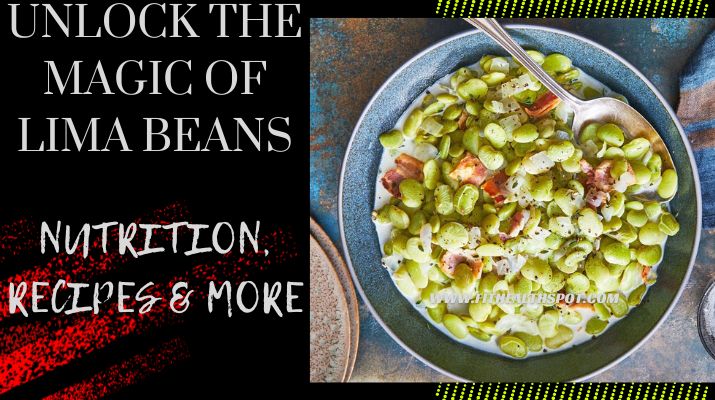Introduction
Lima beans, a cornerstone in nutritious diets worldwide, are a remarkable blend of taste and health benefits. Originating from the heart of South America, these versatile beans have found their place in myriad dishes across the globe, each variant bringing its unique flavor and texture to the plate.
Just as we’ve explored the myriad health benefits of other foods, like the antioxidant-rich green olives, lima beans promise a foray into a world of nutrition and taste. In this guide, we’ll dive deep into lima beans, highlighting their varieties, benefits, and the best ways to incorporate them into your meals.
Unraveling the Mystery: Lima Beans Vs. Their Counterparts
Lima beans have, over the years, gained significant attention, not just for their health benefits but also for the confusion surrounding their name. With various counterparts in the legume family, it’s not unusual to get perplexed about which bean is which.
Lima Beans Vs. Butter Beans: Clearing the confusion
Firstly, let’s tackle one of the most commonly asked questions in the legume world: the difference between lima beans and butter beans. At a glance, these beans might appear similar. Both have a buttery texture when cooked, and they often get used interchangeably in recipes. However, there are distinctions. Lima beans, generally smaller and green, are different from butter beans, which tend to be larger and have a more creamy hue. While their nutritional profiles are somewhat similar, regional preferences and dishes might lean more towards one over the other.
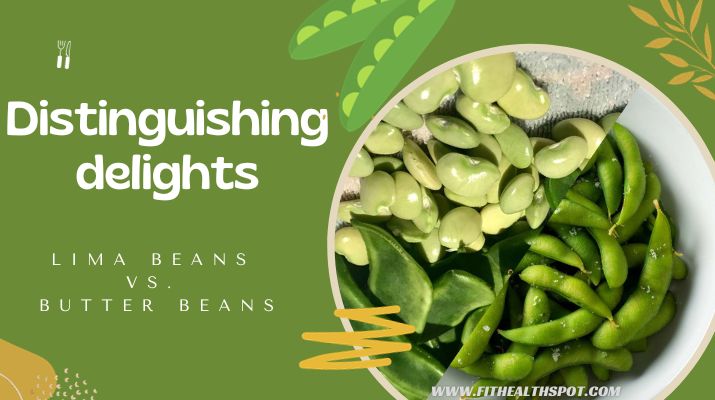
Are butter beans and lima beans identical?
Herein lies the twist. In many parts of the world, especially in the southern United States, “butter beans” is commonly used to refer to lima beans. The name stems from their rich, buttery texture. However, botanically, they are essentially the same bean. The difference in name and appearance usually boils down to regional variations and the specific cultivar of the bean. So, while a dish in the U.S. might feature butter beans, it might use the same legume that another country calls lima beans.
For those interested in how other foods differ by region or type, like the numerous varieties of green tea, understanding these nuances can provide a richer culinary experience.
Fordhook Lima Beans: What sets them apart?

Fordhook lima beans are often considered the gem of the lima bean world. These beans, larger than most other varieties, are characterized by their curved, plump shape and a distinct creamy flavor that’s rich and satisfying. Originating in the chilly gardens of Doylestown, Pennsylvania, the Fordhook variety was a breakthrough in bean cultivation. Its thicker skin ensures it retains its shape during cooking, making it a favorite for stews and salads. The name ‘Fordhook’ might sound industrial, but it’s rooted in the picturesque Fordhook Farm, where this bean variety was first popularized. These beans aren’t just a treat for the palate; their high fiber and protein content make them a nutritional powerhouse, much like other health staples in a conscious eater’s pantry, such as the fiber-rich oat bran.
Fava Beans Vs. Lima Beans: Key differences

Beyond the lima bean family, we encounter the fava bean, a legume that has graced Mediterranean dishes for centuries. While fava and lima beans share a similar greenish hue, the resemblance stops there. Fava beans are larger with a slightly flattened appearance, encapsulated in a thick pod. Nutritionally, while both beans are a good source of protein and fiber, fava beans have the edge regarding iron and folic acid content. Regarding taste, fava beans offer a slightly nutty flavor, contrasting with lima beans’ creamy and mild taste.
Edamame Vs. Lima Beans: A nutritional comparison
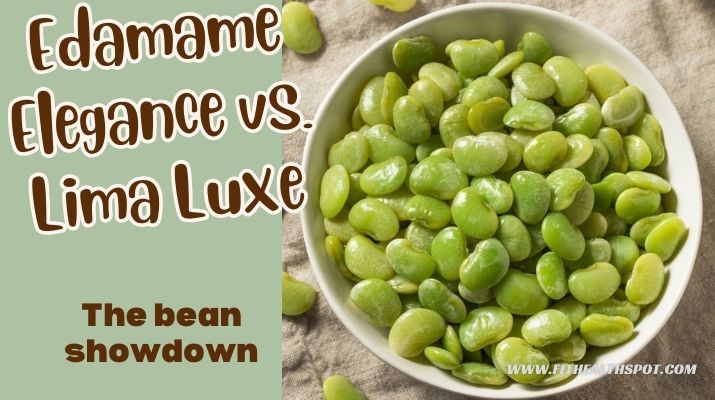
Edamame, young soybeans often associated with Japanese cuisine, is another bean that’s frequently compared to lima beans. On the face of it, both beans share a vibrant green hue and a similar size. However, edamame beans are typically harvested earlier, resulting in a slightly sweeter taste. Nutritionally, while both beans are an excellent source of protein, edamame has a higher protein content and also boasts isoflavones, compounds known to have various health benefits. On the other hand, lima beans offer a more diverse range of vitamins and minerals. Regarding preparation, edamame is often boiled or steamed and served with a sprinkle of salt, making it a popular appetizer or snack. With their versatile nature, Lima beans find their way into various dishes, from soups to casseroles.
Essential Nutrients in Lima Beans: A Comprehensive Look
Lima beans are a nutritionist’s dream, packed with essential nutrients that play pivotal roles in our health. Let’s dive deep into the core components that make lima beans a superfood.
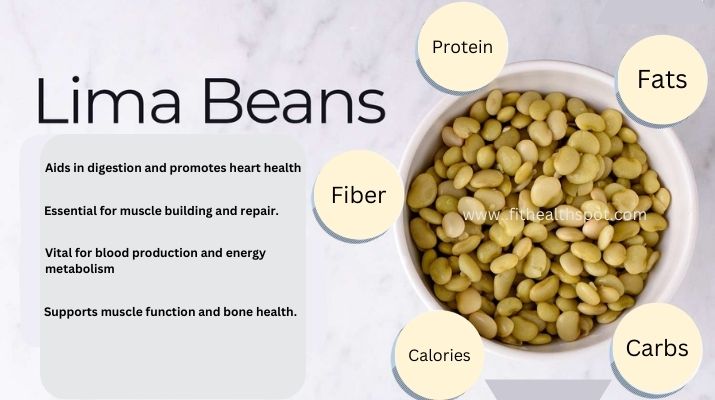
Caloric Content and the Importance of Moderation
- Similar to other legumes, Lima beans provide a moderate number of calories, making them a smart choice for individuals seeking a well-rounded diet.
- While they provide sustained energy, consuming them in moderation is crucial, balancing them out with other dietary elements.
Proteins: The Building Blocks
- Proteins are indispensable for cell repair, growth, and muscle building.
- Lima beans make for a superb protein option, especially advantageous for individuals adhering to a vegetarian or vegan diet.
Fats: A Double-Edged Sword
- Lima beans contain minimal fats, most of which are unsaturated and heart-healthy.
- Certain vitamins rely on fats for absorption while contributing to sustained energy.
Carbohydrates: Fueling Your Day
- They serve as the primary energy source, supporting daily activities and brain function.
- Lima beans provide complex carbohydrates, ensuring steady energy release and stable blood sugar levels.
Fiber: Beyond Just Digestion
- A crucial component for digestive health, ensuring smooth bowel movements.
- Fiber contributes to weight control by enhancing satiety and maintaining favorable cholesterol levels.
Vital Minerals: Diverse Benefits
- Manganese: Aids in bone development and enzyme function.
- Copper: Essential for red blood cell production.
- Magnesium: Supports muscle and nerve function.
- Vital for oxygen transport in the blood.
- Potassium: Regulates blood pressure and supports cellular functions.
Essential Vitamins: Boosting Wellness
- Thiamin (Vitamin B1): Supports metabolism and nerve function.
- An antioxidant enhancing iron absorption and boosting immune function.
- Vital for the development and functioning of the brain.
- Collaborates with calcium to enhance the strength of bones and teeth.
For a comprehensive guide on other nutrient-rich foods, check out our deep dive into the health benefits of buckwheat flour, another superfood that promises wellness.
The Health Boons of Lima Beans: A Deep Dive
Lima beans aren’t just a tasty addition to your meal; they have many health benefits that can boost overall wellness. Here’s a detailed look into how these beans can positively impact your health..
Promoting Heart Health: The Lima Beans’ Secret
- Lima beans are a rich source of both soluble and insoluble fiber. Dietary soluble fiber can aid in the reduction of blood cholesterol levels, thus decreasing the risk of heart disease.
- Potassium and magnesium in lima beans can help regulate blood pressure, ensuring smoother blood flow and reducing strain on the heart.
- Additionally, the low sodium content in lima beans is another boon for heart health, especially for those monitoring their salt intake.
Lima Beans: Can They Be Your Weight-Loss Ally?
- High fiber content means they’re slowly digested, keeping you fuller for longer. This can help curb unnecessary snacking and reduce overall calorie intake.
- Their low glycemic index ensures a slow release of sugars into the bloodstream, preventing sudden spikes and crashes in energy levels and aiding in weight management.
- The protein content in lima beans can support muscle growth, which boosts metabolism and aids in burning more calories.
Loaded with Protein: Powering Your Body
- Lima beans provide a valuable source of protein, making them particularly beneficial for vegetarians and vegans. Protein is crucial for repairing body tissues, making enzymes, and supporting overall bodily functions.
- Protein intake also aids in muscle growth and repair, especially vital for those who engage in regular physical activity.
- Did you know? Protein-rich diets can also help stabilize blood sugar levels, making lima beans valuable to meals.
Ample Fiber: More than Just Aiding Digestion
- While most associate fiber primarily with digestion, its benefits are vast. Beyond promoting regular bowel movements, fiber helps regulate blood sugar levels.
- Furthermore, for those looking for a gut health ally, lima beans’ fiber can promote the growth of healthy bacteria in the intestines.
To further enhance your dietary choices and their impact on your health, consider exploring the advantages of green tea shots, another powerhouse of health benefits.
Understanding Potential Downsides: Every Silver Lining Has a Cloud
While lima beans offer many health benefits, it’s essential to be aware of potential downsides to ensure they’re consumed safely.
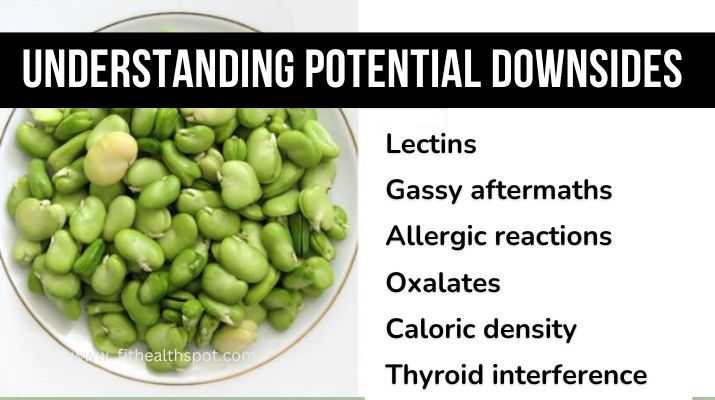
Lima Beans: Potential Risks and Precautions
- Raw Beans Caution: One significant risk associated with lima beans is their linamarin content. This compound can become toxic cyanide in the digestive system when raw or undercooked. It’s vital to ensure that lima beans are properly cooked to eliminate this risk.
- Digestive Discomfort: Similar to numerous legumes, lima beans possess oligosaccharides, a type of sugar that can be challenging for certain individuals to digest, potentially causing gas and bloating. Proper preparation and cooking can reduce these effects.
- Allergy Alert: Though rare, some individuals might be allergic to lima beans. It’s essential to be aware of any adverse reactions when introducing them to your diet, especially for the first time.
Lima Beans in the Kitchen: Cooking the Perfect Beans
Lima beans, with their buttery texture and delicious taste, can be a delightful addition to various dishes. Here’s how to ensure you’re getting the most out of them.
How to Cook Lima Beans for Maximum Benefits
- Soaking is Key: Soak the beans in water for several hours or overnight before cooking. This not only reduces cooking time but also helps in reducing the oligosaccharides that can cause digestive discomfort.
- Boil Away: Always boil lima beans for at least 10 minutes to eliminate any potential toxins. After this, they can be simmered until tender.
- Seasoning Matters: Enhance their natural flavor with herbs like rosemary, thyme, and bay leaves during cooking.
Tips for Preparing and Eating Lima Beans
- Versatility is King: Lima beans can be incorporated into soups, stews, salads, and mashed as a side dish.
- Pair with Whole Grains: Pair lima beans with whole grains like brown rice or quinoa for a complete protein meal.
- Storage Tip: Cooked lima beans can be refrigerated for up to five days. Consider freezing portions for later use if you’ve made a large batch.
For those who love experimenting in the kitchen, here’s an exciting guide on cavatappi pasta and its health benefits, allowing you to combine the goodness of legumes and grains in creative dishes.
Spotlight on White Beans: The Unsung Heroes of Legumes
White beans, sometimes overshadowed by green varieties, such as navy or pea beans, boast their unique nutritional value and culinary adaptability.
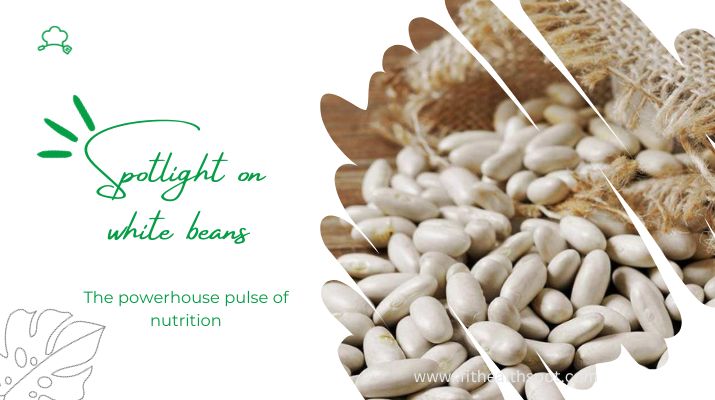
Nutrients and Benefits of White Beans
- Rich in Fiber: Much like lima beans, white beans are a commendable source of dietary fiber, supporting digestion and promoting a feeling of fullness.
- Packed with Protein: An excellent source of plant-based protein, white beans can be a significant part of a vegetarian or vegan diet.
- Minerals Galore: Rich in iron, calcium, and magnesium, white beans support bone health, energy production, and muscle function.
- Vitamin Boost: They come loaded with essential vitamins, especially folate, crucial for DNA synthesis and repair.
How White Beans Compare to Lima Beans
- Texture & Taste: While lima beans are known for their buttery texture, white beans have a slightly grainy and nutty flavor.
- Nutritional Profile: Both beans have a comparable nutrient profile, with lima beans having a slight edge in certain minerals. However, white beans often have higher iron and folate content.
- Culinary Uses: Both beans can be used interchangeably in many recipes. Yet, white beans are often preferred in soups and stews due to their ability to thicken broths.
For a deeper dive into other beneficial foods, consider checking out the myriad benefits of green olives and their varieties.
Conclusion: The Final Word on Lima Beans
In the vast world of legumes, lima beans stand out for their distinctive taste and myriad health benefits. From supporting cardiovascular wellness to facilitating weight management, these beans are crucial to a well-rounded diet. Their versatility in the kitchen ensures that there’s always a new way to enjoy them. As we’ve seen, even their closest relatives, like white beans, offer fantastic nutritional value, making legumes an essential food group for everyone.
Encourage yourself to incorporate lima beans into your meals. Be it a creamy soup or a zesty salad, there’s always room for these green wonders. Remember, the key is in the preparation, so ensure they’re cooked well to derive maximum benefits.
Additional Resources: For the Enthusiastic Foodie
Hungry for more? Dive into these further readings and guides:
- : From salads to mains, discover the countless ways to cook and enjoy lima beans.
- Health Benefits of Green Tea: Discover the secrets and benefits of green tea shots.
- Dive into Buckwheat: Unlock the nutritional treasure of buckwheat flour and its amazing benefits.
- Understanding Fasting: Decode the mysteries behind intermittent and dry fasting and how it can revolutionize your health journey.
Frequently Asked Questions about Lima Beans
What are Lima Beans?
Lima beans, also called butter beans, belong to the legume family. They’re rich in protein, fiber, vitamins, and minerals, offering a healthy boost to any eating plan.
Are Lima Beans and Butter Beans identical?
Yes, lima beans and butter beans refer to the same legume. The name “butter beans” is commonly used in certain regions, such as the U.K., due to their buttery texture.
How Do Fordhook Lima Beans Differ from Regular Lima Beans?
Fordhook lima beans are a specific variety of lima beans that are larger and creamier than their baby lima bean counterparts.
Can You Eat Lima Beans Raw?
Consuming raw lima beans is discouraged due to their naturally occurring toxin called linamarin, which can be harmful in excessive quantities. Cooking destroys this toxin.
How Do Lima Beans Benefit Heart Health?
Lima beans are rich in soluble fiber, which can help lower cholesterol levels. They also contain various heart-healthy minerals like Potassium and magnesium.
Are Lima Beans Good for Weight Loss?
Yes! Lima beans are low in calories, protein, and fiber-rich, making them an excellent food for those looking to shed weight.
How Do Lima Beans Compare to Edamame or Fava Beans in Nutrition?
All three beans are nutritious, but they have varying nutrient profiles. For instance, edamame is higher in protein, while lima beans have more fiber. On the other hand, Fava beans have a unique set of phytonutrients beneficial for health.
What Are Potential Downsides or Allergies Associated with Lima Beans?
While lima beans are generally safe for most people, they can cause allergic reactions in a minority. They also contain antinutrients, which can affect the absorption of certain minerals, but these are reduced with proper cooking.
How Can I Incorporate Lima Beans into My Diet?
Lima beans can be added to soups, salads, casseroles or enjoyed as a side dish. Try them in a bean salad with vinaigrette or a hearty bean soup for a tasty preparation.
Where Can I Find More Information on Healthy Foods and Diets?
For an in-depth dive into other healthful foods and their benefits, consider exploring articles on green olives, green tea shots, or intermittent and dry fasting principles.

